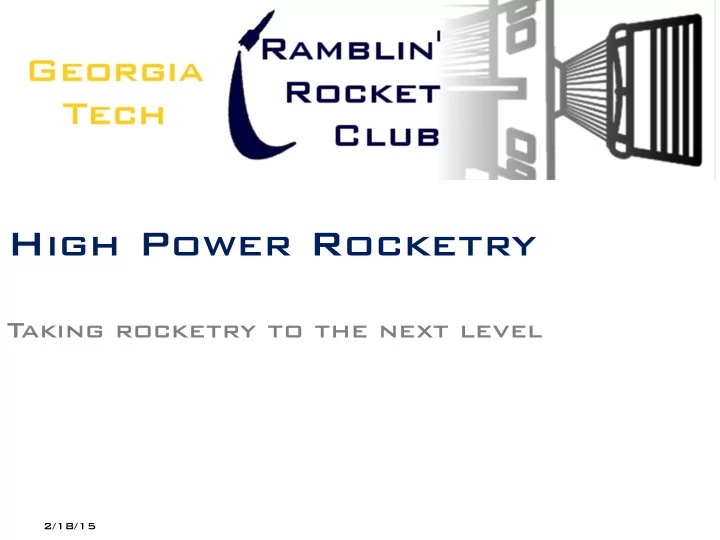

High Power Rocketry Taking rocketry to the next level 1 2/18/15
What is a High Power Rocket? • Not to be confused with a model rocket • Significantly larger, more powerful, more dangerous • Need FAA waivers to fly • Uses ammonium perchlorate composite propellant (APCP) or experimental propellants – Typically not black powder 2/18/15 Ramblin’ Rocket Club 2
Rules and Regulations • NFPA 1127 • High Power Rocket Safety Code – Certification – Materials – Motors – Ignition system – Misfires – Launcher – Size – Flight safety – Launch site – Recovery system 2/18/15 Ramblin’ Rocket Club 3
How do I get certified? National Association of Tripoli Rocketry Association Rocketry (NAR) (TRA) • Level 1 • Level 1 – Build and successfully fly a – Build and successfully fly a conventional rocket with a single conventional rocket with a single H or I commercial motor. H or I commercial motor. • Level 2 • Level 2 – Build and successfully fly a – Build and successfully fly a conventional rocket with a single conventional rocket with a single J, K or L commercial motor and J, K or L commercial motor and pass a written exam. pass a written exam (88% or • Level 3 better). – Build and successfully fly a • Level 3 conventional rocket with a single – Build and successfully fly a M, N, or O commercial motor and conventional rocket with a single have the design verified by 2 TAP M, N, or O commercial motor members and have successfully and have the design verified by completed a flight using electronic the L3CC. deployment mechanisms. 2/18/15 Ramblin’ Rocket Club 4
Level 1 High Power Rockets • Impulse range 160-640 N-s OR • Greater than 80 N average thrust OR • Greater than 125g of propellant OR • Uses a hybrid motor OR • Weighs more than 1.5 kg including propellant OR • Includes ductile metal in the airframe • Includes H and I motors 2/18/15 Ramblin’ Rocket Club 5
Level 2 High Power Rockets • Impulse range 640-5,120 N-s • Includes J, K, and L motors • More advanced rocket systems than Level 1. 2/18/15 Ramblin’ Rocket Club 6
Level 3 High Power Rockets • Impulse range 5,120-40,960 N-s • Includes M, N, O commercial motors and larger experimental motors • Typically involve electronics for deployment and much heftier construction. 2/18/15 Ramblin’ Rocket Club 7
Class 3 Rockets • A rocket with total impulse exceeding 40,960 N s • Equivalent to a P motor and greater • Requires a special FAA approval in addition to FAA waiver 2/18/15 Ramblin’ Rocket Club 8
Engineering Considerations • Stronger materials – Fiberglass, carbon fiber, thick plywood • Electric systems – Parachute deployment, data sensing and acquisition, tracking, beaconing, lights • Aerodynamics – Stability, fin flutter, Mach number • Thermal – High velocities, recovery pyros, electric systems 2/18/15 Ramblin’ Rocket Club 9
Recommend
More recommend